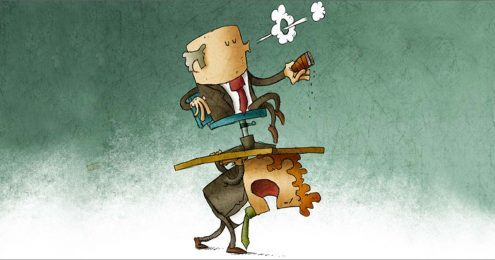So riddle me this batmen and women.
Tell me the ONE thing that tells you a nonprofit is thriving.
You can pick just one.
No fair you say? Well it’s MY blog so my rules. But let me help you get your creative juices flowing.
Let’s start with the wrong answers. It has nothing to do with:
- A strong mission
- A cash reserve
- The diversity of your revenue streams or meeting your annual revenue goals
- Your staff turnover %
- The size of your board
Yes, these things are really important, but the charge here is to pick ONE. And these aren’t it.
OK, give up?
Read on and I’ll give you the right answer.
FIRST, A BIG HINT
OK, here’s a hint. It has to do with a specific kind of relationship.
Which one am I talking about? After all, nonprofits are riddled with important relationships. Maybe I’m talking about the relationship between the ED and staff, or donors, or constituents. Maybe it’s the board and donors. Or the relationship between staff members?
Which relationship in a nonprofit is the single most important indicator of that nonprofit’s health?
Did you get it yet?
THE SINGLE MOST IMPORTANT HEALTH INDICATOR IS…
In 2013 I became a certified mediator for one simple reason: so much of my work is connected to the dysfunctional relationship between the two true organizational leaders: the Board Chair and the CEO. They need to work together like co-pilots in a twin-engine jet.
In my opinion, this relationship tells you more about the health of a nonprofit than any other single factor.
Take a look again at the list I gave you at the beginning of this article. The one I said didn’t have the right answer. Notice something?
Shared leadership with an invested thought partner with leadership skills can cut them all off at the pass.
The board chair and CEO need to act like co-pilots in the cockpit of a twin-engine jet, working in tandem to steer the plane safely.
But oy! There are just SO MANY THINGS that can go wrong…
THE TOP 10 SIGNS OF A DYSFUNCTIONAL CEO / BOARD CHAIR RELATIONSHIP
I fear you will recognize some of these in your own organizations.
- Board Chair didn’t want the job in the first place. Was the only person who didn’t step back when the ask was made.
- CEO doesn’t tell the Board Chair anything meaningful. Keeps her at arm’s length. Hopes they don’t interact a lot. Perceives interaction as “intrusion.”
- Board Chair intrudes. Sees the role as good old standard boss/employee relationship and attempts to micro-manage the activities of the CEO.
- Board Chair actually wants the CEO job.
- Board Chair comes in distrusting / disrespecting the CEO and uses the platform to make the case that it is time to boot him.
- CEO believes that the Board Chair’s primarily role is to ‘protect’ her from the big bad Board.
- Board Chair sees her role as providing cover for CEO and to ‘save’ her from the annoying board with their nutty ideas.
- Board Chair is not accessible to the CEO when she needs him.
- There is no regular communication in either direction.
- Board chair delegates board and executive committee meeting agendas and actual running of the meeting to the CEO.
BAD RELATIONSHIP, BAD NONPROFIT
A bad relationship between the CEO and Board Chair causes so many problems.
First of all, major problems get swept under the rug. Nobody wants to discuss them. And when you don’t talk about problems, you don’t solve them, and they just get bigger.
Without a great relationship between the two leaders, the board can become completely ineffective. I’ve seen this over and over. Board members become less engaged and cannot champion the cause. Committees don’t function (especially scary when it’s the Audit and Finance committee we’re talking about.) Sometimes the CEO winds up managing the board and she already has way too much on her plate.
Board problems can become systemic if these two leaders do not lead in building a leadership pipeline.
The CEO himself might be great, but a bad Board Chair could fire him or cause him to resign in frustration. And in the other direction, a CEO who keeps the Board Chair at arm’s length is simply not doing her job.
The dysfunction can spill over to the staff. Believe me – they know when this relationship isn’t working. It’s a HUGE morale problem.
Oy. What a mess. So how do you fix it?
A great CEO – Board Chair relationship is one of the most important things you can focus on as a nonprofit leader. In fact, this “co-pilot” relationship is one of 3 keys to building a thriving nonprofit?
What are the other two?
Stay tuned!




What do you do when both the board and the CEO of the non profit are both incompetent and the CEO has recruited board members who can only say “yes” to what ever the CEO says, and adding more to the frustration of the staff, the CEO barely shows her face in the office, taking advantage of the “yes” board, who has no idea or desire to exercise their power and put the CEO on the hot seat. No annual evaluations, no proper planning everything is just disgusting.
Wow. There is a whole lot of dysfunction going on there. Before determining it is a loss cause, consider your one passion for the work. Is it an 8 or higher on a 10 point scale. If not, you need to consider your ability to stay. If it very high, the only hope is to seek out other board or staff who are equally committed. If you watch Survivor, it’s like building an alliance. Even if it is only you and 2 others. Strategize together about how to transform this into something that functions. What could you do? What would need to happen? If you can’t create a strong alliance, you might be fighting a losing battle. Maybe time to find a gig working at another organization in the sector you care about — an organization that has some real strengths in terms of management and commitment.
Thanks for your feed back. I am so frustrated that I am confronting the CEO myself. I really love what I do, that is why I want to fix all these dysfunction. The CEO has done a very good job of hiring people who are good at saying Yes to everything she does. They are frustrated to but don’t have the guts anymore or may be they need the job to support themselves. I don’t blame them. I blame the CEO and the Board. I don’t care at this time, but I will fight as long as I can to see if I can save this sinking ship.
Good luck. Sounds like your organization is very lucky indeed to have you and your passion and determination.
Thanks for listening. I know I can’t fix everything, but I would definitely like to start somewhere and take it from there. I did try to talk to the CEO last week, she did not listen, but started saying that nobody appreciates how hard she works, and lot of other things. There are only 4 full time staff (including the CEO) and 2 part time, there has been no job analysis done in the last god knows how long, the job descriptions are dated, no performance evaluations done in the last 3, 4 yrs, that includes the CEO – could be even more, no website, no voice mail, dated softwares, no admin help – you name it and we don’t have it or have not done it. I can go on and on with it. The board has never been trained. They don’t even know what their powers are and seems like they don’t even care. The CEO has been with the org. for more than 20 years and I feel she is completed saturated, but refuse to recognize that and would not let go. My question is why do we have to wait for something bad to happen, before we do something. Why do we have to wait for the CEO to really mess up, and hope that then the board might wake up and do something(just hoping). We do a great job within the community, but if we go at this rate, we will be gone in few years and a program that helped so many people have a better life will be gone, because of some silly egos and mistakes that could have been easily prevented. I would like to discuss more if you could contact me through my email. Thanks for listening.
Excellent! I just sent this to my former board pres and current board pres. with a thank you for being such effective leaders. I am happy to tell my staff, when I do my annual reviews that I get reviewed by the board, and that I am accountable to the board just as they are to me. It’s a great gift.
Bill. A gift. A perfect way to describe it. And sending thank you notes to current and former board president? Smart and kind. Folks need to see evidence of great partnerships. Thanks.
Outstanding insight and since this is your blog, you absolutely retain the right to declare which is the most important relationship. May I offer at least one of equal import; that being between the organizations leadership and it’s volunteers? The value of time is woefully underestimated… some of the greatest volunteers were once strong leaders in assorted fields and if current leadership would have the ears to hear, the force multiplier for organizations would be exponentially increased. If we treat volunteers with the same respect and recognition as our staffs, the sky is the new ceiling of potential for our mission.
Joe – I think of this as OUR blog so I’m glad for your insights as well! I think your comments about volunteers is spot on. Especially as boomers age and retire early there is a huge untapped army of folks with all kinds of skills and all kinds of passions who can be engaged. I hope that organizations keep this in mind. The demographic shift has huge upside for nonprofits.
What about when the President IS the board chair??!!! Yeeeesh.
Great discussion and responses, Joan. I would add that the Chair’s understanding of the CEO’s relationship to the capacity and morale of the staff is equally important for chair to ascertain independent of CEO. In the most successful and highly functioning NPOs I have worked with, the chair and exec committee have established working relationships with other senior staff, as well and a chance to engage openly (not micro manage or sneak behind CEOs back) with other staff when appropriate to learn about work, successes and challenges.
Gordon. Yeesh is right. And this is a model that is destined to fail. time for the organization to buck up and change it. Conflicts of interest galore here. I’ve seen it and it’s not good. At all.
Danielle. Great topic for another blog post. So many CEO’s are rightfully protective of senior staff relationships with boards and yet there has to be an illustration of bench strength and a team approach to the leadership of the organization.
Please do not roll your eyes at the dumb question, does CEO mean President of the BOD or someone else (Founder?) or ED.
Many NFPs do not have CEO, BOD chairs, and EDs. The two I work with do not; the smaller one has a BOD (with elected president) and committee chairs for projects and events while the other larger one has a BOD (elected president), selected ED, and ‘volunteer’ Executive staff (and then many other layers…). There are days I feel a bit schizophrenic when dealing with these two groups.
I have enjoyed reading your ‘stuff’ and find it to be extremely helpful. m
Some nonprofits use the term CEO. Others use ED. But either way, you’re talking about the #1 staff person. The day-to-day leader. Not the BOD chair.
It’s possible to have a small nonprofit without a full time staff, of course, in which case there probably wouldn’t be a CEO or ED.
Marianne. This is SO not a stupid question. I often use executive director and CEO interchangeably. Larger organizations tend to use CEO – often a perk in lieu of $$ 🙂 Smaller orgs use E.D. There are also Board Chairs and Board Presidents. They are, in my mind, interchangeable.
Thank you both. Precise words, as well as clear policies and procedures, help when dealing with ‘who’s who’ in NFP chess game. 😉 Funny, when one has to write things down, confusion can abound, but that gives clarity a chance to follow.
11. Board chair comes in with a long list of “the way it should be done” based on other organizations they have been on the board of, and doesn’t take the time to find out how we do it here and why.
12. Board chair empowers the executive committee to do all the important thought work, leaving actual board meetings to be just him/her reporting with no discussion from the rest of the board – they sit there in silence for 90 minutes.
13. The board chair is so determined that certain directions cannot even be considered, much less taken, that months of make-work are manufactured so that the discussion can never be had.
14. The board chair won awards for good governance in other organizations, so his/her expertise can never be questioned
15. The board chair can talk louder and longer than anyone else so everyone include the CEO just shuts up so they can leave on time.
16. The board chair complains about everyone behind their back but is unwilling to discuss his/her concerns to anyone’s face. Including griping about the CEO’s participation in a master’s degree program that the previous board voted to allow time for, but the organization is not contributing to the cost of. (MPA so directly applicable to CEO’s job.)
17. The CEO, who has been there 15 years and is passionate for the mission, highly educated in governance and management, and has been willing to work to adapt to the styles of 8 or so previous board chairs, each with very different backgrounds and personalities, has her eye on the door.
Thank you for this excellent article. It has helped me to reinforce my feeling and action to transform the organization I work for. To everything there is a turn, I also realize that it’s more than just passion for what you believe in there must be positive attitude and action. Mildred
Yes!!! That is exactly the reason I created my comic strip Clarise and the Board. http://Clarise.ca Nobody wins an internal conflict. It’s also a difficult subject to talk about openly.
Bill. i need to look. I am so intrigued!!!!!!
What did you think?